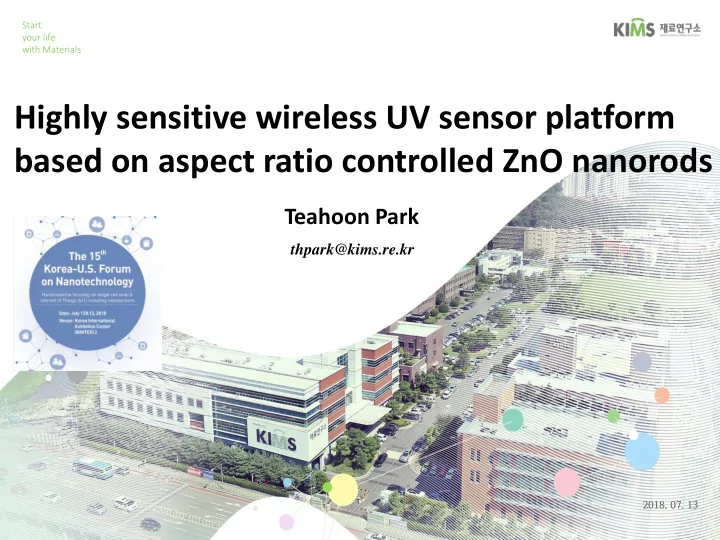

Highly sensitive wireless UV sensor platform based on aspect ratio controlled ZnO nanorods Teahoon Park thpark@kims.re.kr
Oxygen molecules are adsorbed onto ZnO surfaces by capturing free electrons which creates a low-conductivity depletion layer Upon UV illumination, hole discharge the negatively charged adsorbed oxygen ions to photodesorb oxygen from the surfaces or effectively get trapped at the ZnO surfaces, resulting in an increase in the free carrier concentration To synthesize ZnO nanorods by solution-processing method with controlling the length of them to understand the affects of the length of ZnO nanorods on ZnO nanorods based UV sensors.
High h aspect spect ratio io ZnO nanost nostru ructure cture Solut ution ion proces ocessable sable Fast st & h high h sens ensitiv itivity ty Wire reless less UV s sens ensor r plat atform orm -6 10 58.5 5 times 0.5M 1 M 2 M -7 10 3 M Current (A) -8 10 -9 10 -10 10 -11 10 0 200 400 600 800 1000 Time (sec)
Seeding Step Growth Step Different High concentration concentration Zinc precursor Base Low material concentration
TEM and XRD pattern of ZnO nanomaterials with different aspect ratio
10 -6 0.5M 2.0x10 -6 0.5M 1 M 1.5x10 -6 1 M 2 M 10 -7 2 M 3 M 1.0x10 -6 Current (A) Current (A) 3 M 5.0x10 -7 10 -8 0.0 -5.0x10 -7 10 -9 -1.0x10 -6 -1.5x10 -6 10 -10 -2.0x10 -6 10 -11 -30 -20 -10 0 10 20 30 0 200 400 600 800 1000 Voltage (V) Time (sec) Experiment data Response Current ( A) -6 4.0x10 840 W/cm 2 2 =0.99) Linear fit (R Current (a.u.) -6 665 W/cm 2 3.0x10 -6 368 W/cm 2 2.0x10 253 W/cm 2 -6 1.0x10 162 W/cm 2 0.0 0 200 400 600 800 1000 0 200 400 600 800 1000 UV intensity ( W/cm 2 ) Time (sec) Optoelectric properties of ZnO NRs under repeated UV irradiation on and off
A schematic diagram of the circuitry ZnO NR UV On UV Off UV On Photographic images of the Bluetooth connected ZnO NRs UV sensor module
Conclusion Aspect ratio controlled ZnO nanorods were successfully synthesized via two step processes. The ZnO NR morphology and crystal structure were analyzed. The original wurtzite structure of ZnO was observed. As the length of ZnO nanorods was longer, UV responsivity is 58.5 times higher. The wireless ZnO NR UV sensor platform was operated successfully and the sensing results were observed on a smartphone screen connected through Bluetooth. Future work Fiber type or flexible sensors with high sensitivity based on metal oxide materials. Composites sensor will be prepared for wearable devices.
Recommend
More recommend